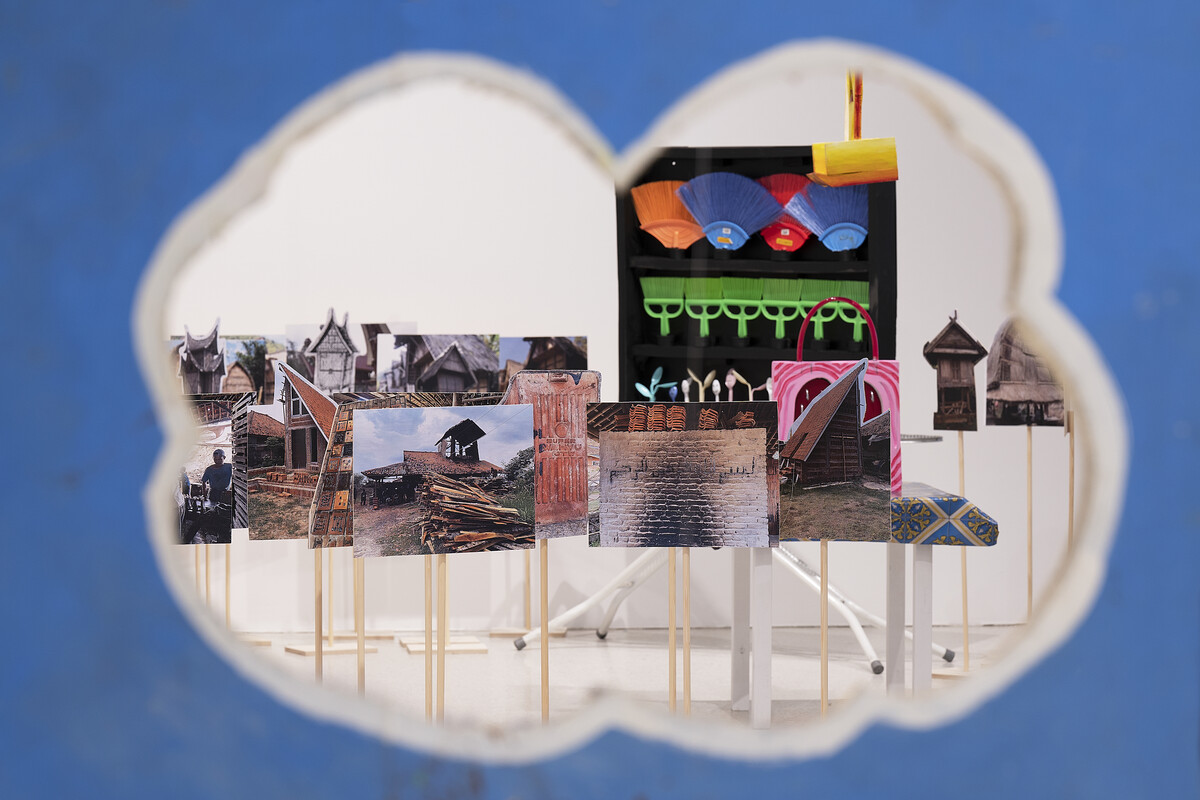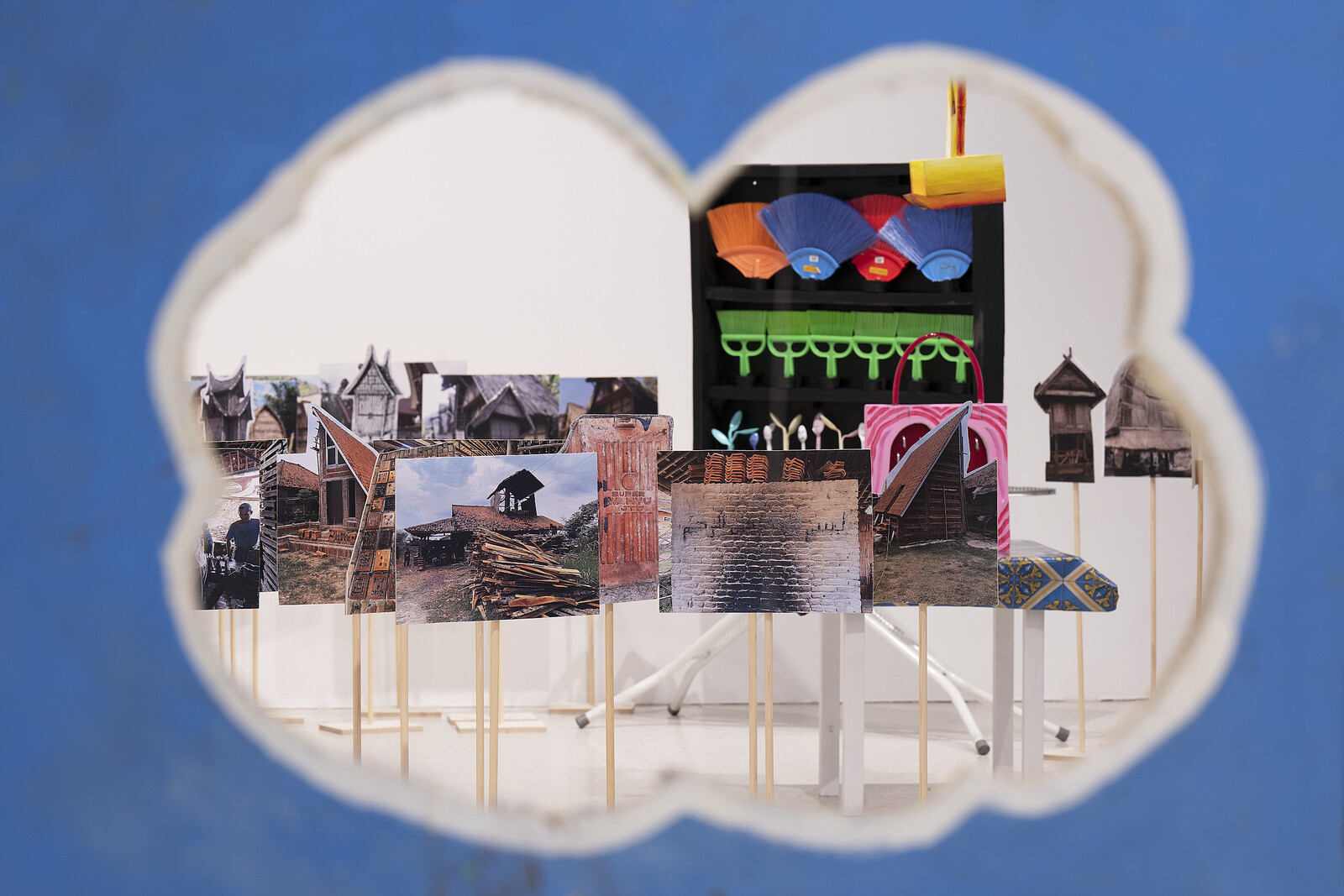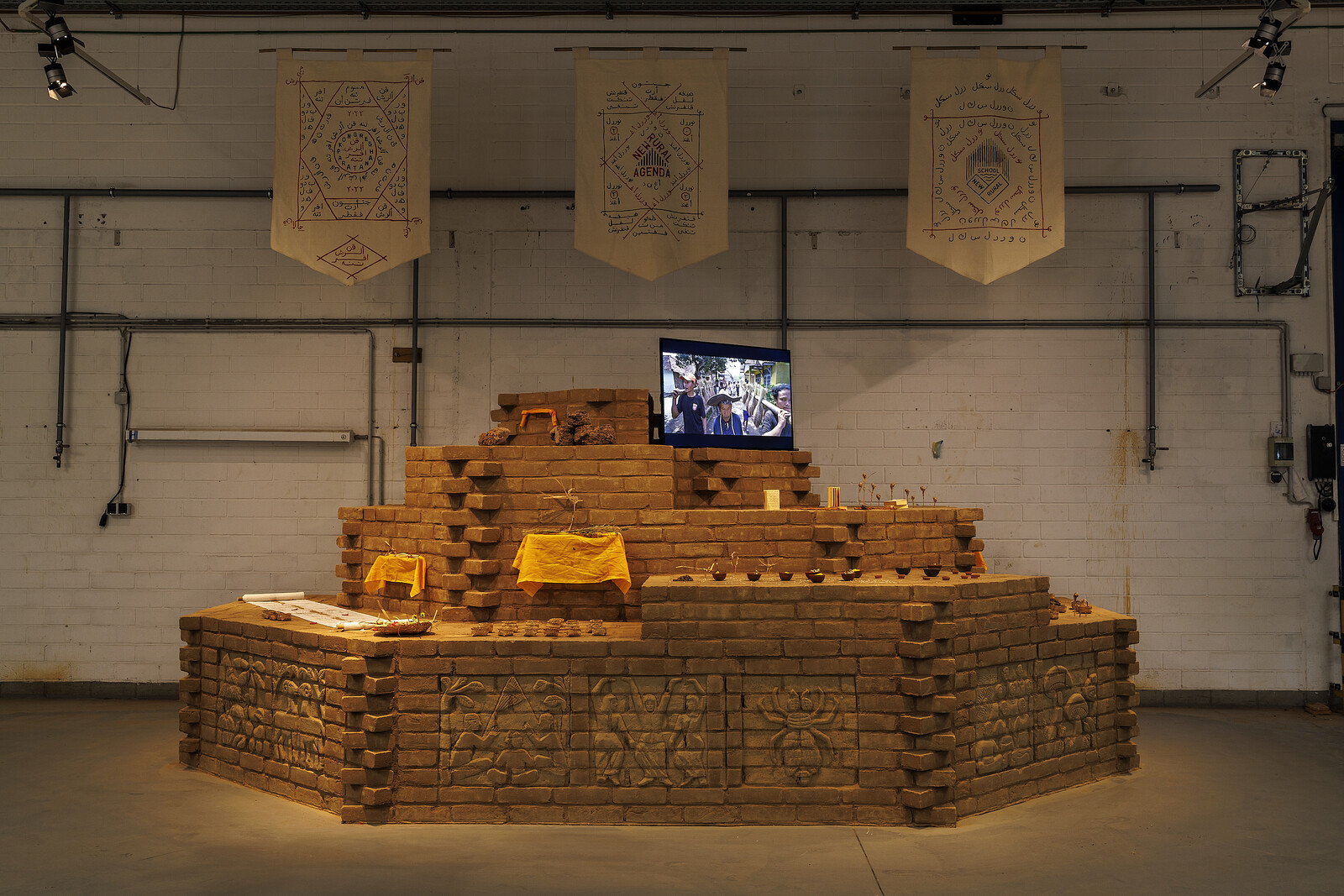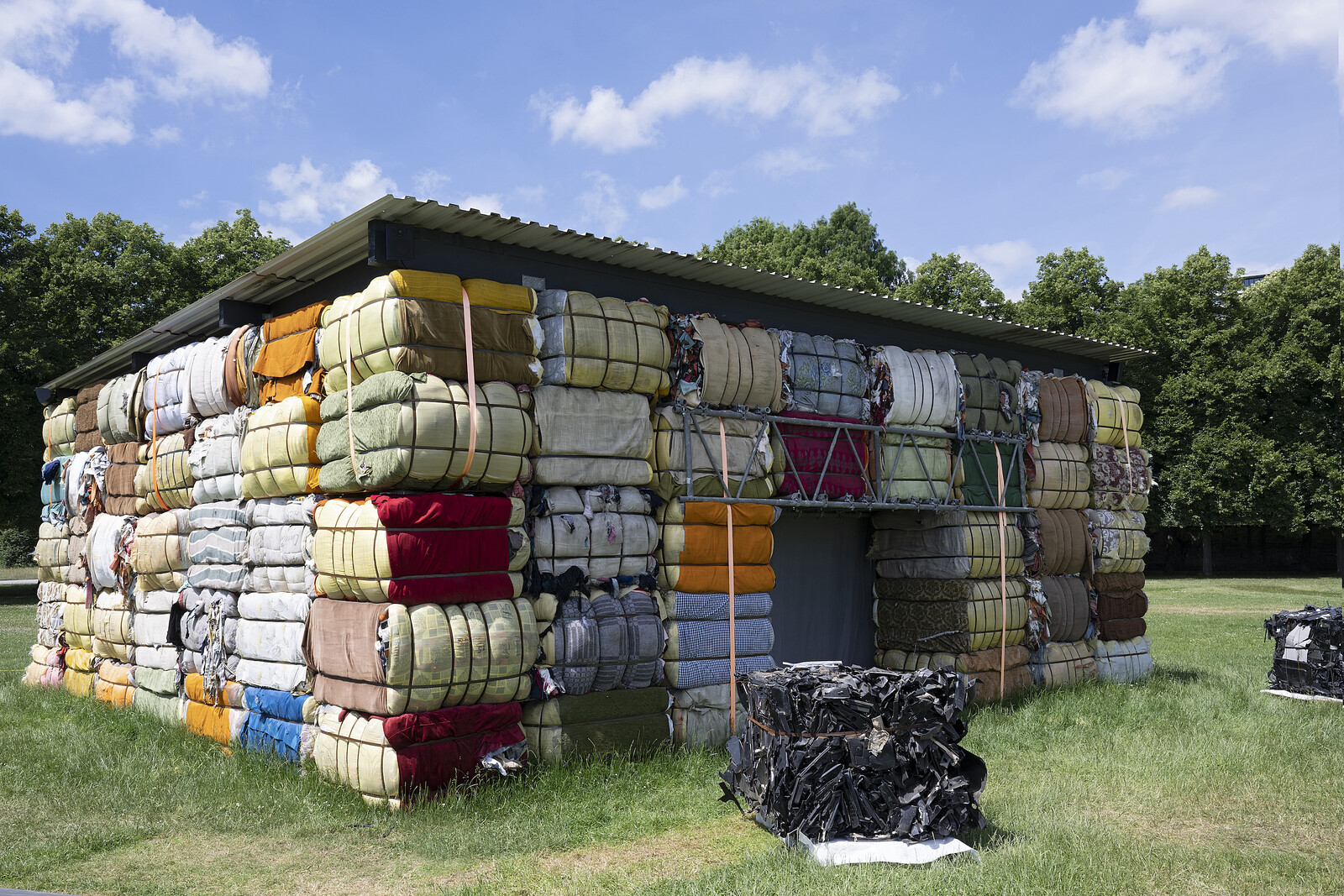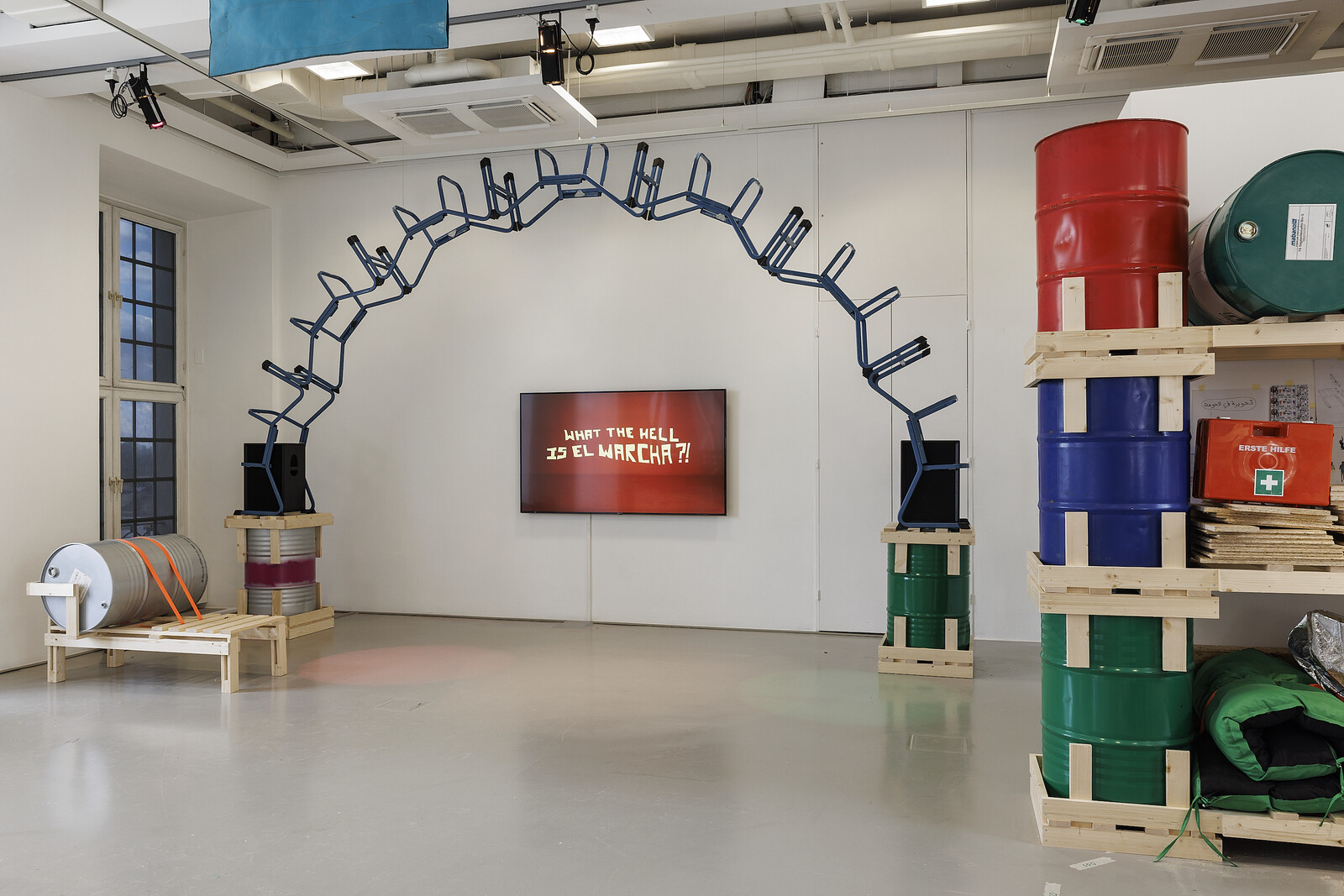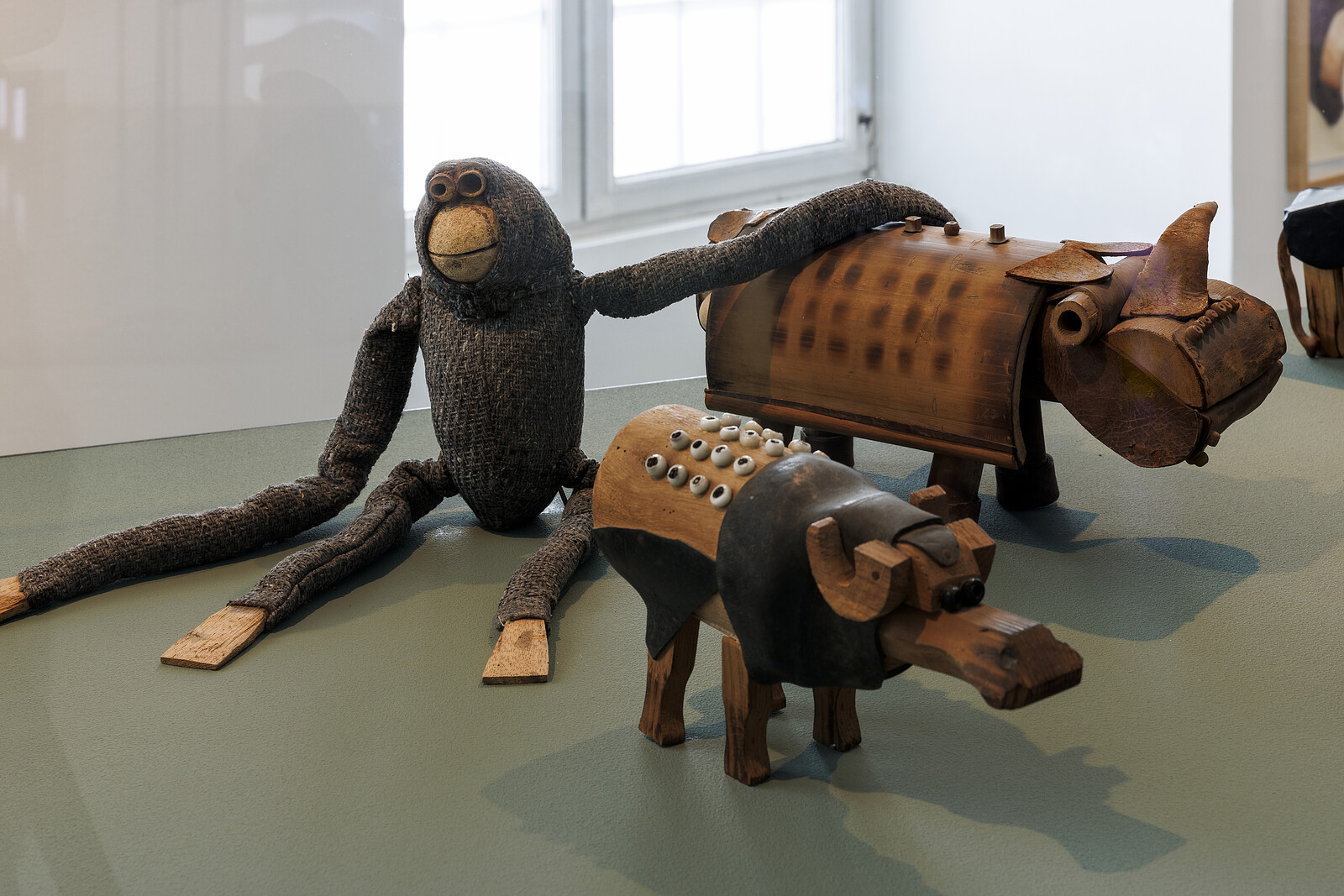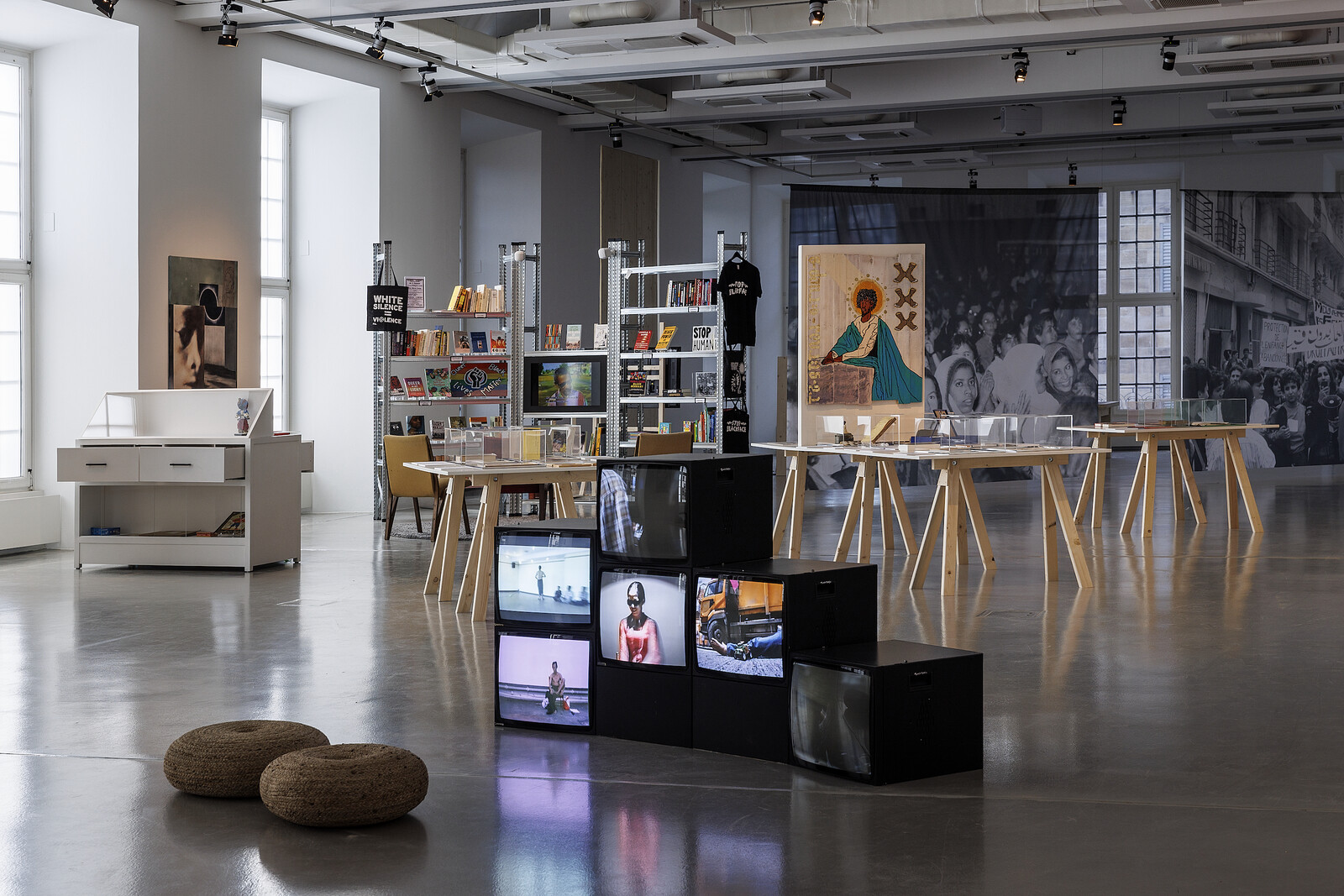June 18–September 25, 2022
In the first of our dispatches from Documenta 15 over the next 100 days, Kevin Brazil considers the exhibition as an experiment in “the art of administration.”
At the opening press conference of Documenta 15, held in a Kassel sports stadium, the Indonesian collective ruangrupa invited the audience to sing along, “karaoke style,” to a music video created by Tropical Tap Water. In the lexicon of terms developed by ruangrupa to explain their curatorial ethos, this video was a “harvest”—a gathering of the fruits of a process—undertaken by one of the 1,500 artists working and sharing resources within the Documenta ekosistem (a more limited number are invited to exhibit). It showed people painting and playing music in studios, with diagrams and flowcharts mapping the stages by which the song was created. Lyrics flashed on screen, riffing on the idea of a “baskom,” or washbowl: “To decentralize Europe / We use the baskom.” Some of the participating artists half-heartedly clapped along, but the audience was otherwise largely silent.
Collaboration, participation, and process over product: these are the practices ruangrupa aim to foster in the activities—from childcare to composting—taking place across Documenta’s 100 days. And, indeed, in the meetings, financing, and decision-making processes that preceded and shaped the exhibition: this Documenta is an exercise in the art of administration. So it makes sense that its title should be derived from that field. “Lumbung,” the Indonesian term for a communal rice barn, also denotes the behaviors that this physical infrastructure enables: the sharing of surplus resources and labor for the collective good.
Given the emphasis on participatory activities over exhibited works, the kinds of collaborations and processes to emerge will only be known after the exhibition itself has ended. Invitations to take part can be refused; collaboration can feel like compulsion when it involves singing to someone else’s script. The cancellation of a forum to debate accusations of platforming anti-Semitic work, alongside the decision to exhibit a banner by Taring Padi and then conceal it after accepting that it “triggers anti-Semitic readings,” demonstrates that collaboration within an exhibition cannot shelter its participants from political conflict and contestation outside it. However broad the invitation to participate, someone must always decide what forms of representation are acceptable, and what—and who—is to be excluded.1
If the program and participants seem at first glance sprawling and undefined, beneath the playful surface of singalongs and puppet shows lies a firm set of principles. Participants are predominantly (but not exclusively) collectives from the Global South whose practices shape social relations through art “functioning in real lives in their respective contexts.” Art which pursues “mere individual expression” or which intends “to be exhibited as standalone objects or sold to individual collectors and hegemonic state-funded museums” is explicitly rejected. “Other ways are possible,” ruangrupa declare, echoing the familiar dream of modernist avant-gardes.2 Participatory art, social sculpture, or relational aesthetics have long been advocated as a means of re-unifying art and life: this Documenta feels more like a culminating survey of those artistic practices than a presentation of entirely new ways of integrating aesthetics and politics.
If those “other ways” will only come into being through the communal activities ruangrupa’s curatorial program will activate, for now there is material exhibited at over thirty sites around Kassel. Because ruangrupa encouraged participants not to produce new work, but rather to “harvest” records of projects finished or in progress, this consists in large part of documentation of collaborations. In the Fridericianum and elsewhere, vitrines and videos display research and performances undertaken by nonprofit organizations such as Asia Art Archive and collectives such as The Question of Funding and the Archives des luttes des femmes en Algérie. Painted directly onto walls, the ubiquitous flowcharts aim to communicate the decision-making processes of collectives like the Keleketla! Library from South Africa or Gudskul, based in Jakarta, yet in their scale and stylization they appear more as an iconography of collaboration as spectacle: “a social relationship between people that is mediated by images.”3
Alongside archives and flowcharts, the exhibition spaces are full of temporary facilities for activities still to take place: kitchens, printing presses, reading rooms. Even in their unused state, some of the tensions inherent in this approach to participation and collaboration can be traced. The Speculative Collective Board Game, developed by Gudskul and available to play on a table inside the Fridericianum, is a role-playing game in which players “act as members of an art collective” in order to foster “co-operating, sharing resources, problem solving, and decision making.” Players face challenges like a member starting a family and therefore having less time to give to the collective endeavor. The resolution of a conflict improves the collective’s “bonding” and increases its “social capital.” Success is thus measured by metrics resembling the funding structures that bring a collective into being, and the formation of aesthetic subjectivity made equivalent to a training in assessment, evaluation, and impact. This game suggests that Gudskul imagine their audience as consisting of aspiring artist-administrators and that, for the general public, the art collective is a model for improved social relations.
Some artists have chosen to use the resources provided to produce new works, and these are frequently the most compelling in the show. Film screenings organized by the Komîna Fîlm a Rojava combine documentaries archiving song traditions in northern Syria with new films in which performers sing a polyphonic chorus in a surreal colored grid. Football Kommando (2022), a new feature-length film by Wakaliga Uganda studios, tells the story of a German footballer who is invited to Kampala to appear in a Wakaliga Uganda studios film. It’s an hilariously self-referential inversion of the economy of Documenta that will be legible to all audiences: here, Germany provides the cultural content for Uganda’s pleasurable consumption. Pleasure, too, is the theme of the room in the Stadtmuseum Kassel devoted to FAFSWAG, an Indigenous queer artists collective working across Aotearoa/New Zealand and the Pacific Islands. Whānau Wall (portraits, no year) consists of a grid of lusciously colored, highly stylized portraits and a videogame which asks users to pit members of the collective against one another in vogue battles and choose the winner. Here, as in vogue more broadly, aesthetic judgement and critical evaluation are the means by which conflict in a collective is resolved, rather than inherently hierarchical acts of domination to be expelled from communal life.
It is striking how many exhibition sites are populated with temporary structures: Baan Noorg Collaborative Arts & Culture’s skate ramp, *foundationClass* collective’s lecture hall, El-Warcha’s DIY workshop, Richard Bell’s Tent Embassy (2013-present), Centre d’art Waza’s display plinths and seating spaces. They come across as a parade of institutional prototypes, existing, for now, in the sheltered spaces of the museum, the gallery or—at a stretch—in the equally protected boundaries of the outdoor site specific installation. In their handbook, ruangrupa write that most of the invited collectives “come from contexts in which the state had failed to support the development of infrastructure and a support system for art and culture.”4 Can collaboration transform these models into the infrastructures these artists need? Is a quinquennial exhibition a means to redistribute the resources that will make such infrastructures possible? These are the questions ruangrupa are trying to answer in the game they are playing with Documenta and its audiences.
“On the Concealment of a Work by Taring Padi at Documenta 15,” Documenta 15 website (June 20, 2022), documenta-fifteen.de/en/news/on-the-concealment-of-a-work-by-taring-padi-at-documenta-fifteen (Ed’s note: This issue will be discussed at greater length in our forthcoming coverage of the exhibition)
ruangrupa, documenta fifteen handbook (Hatje Cantz, 2022), 17.
Guy Debord, The Society of the Spectacle, trans. Donald Nicholson-Smith (New York: Zone Books, 1994), 12.
ruangrupa, Documenta 15 handbook (Hatje Cantz, 2022, 24)
